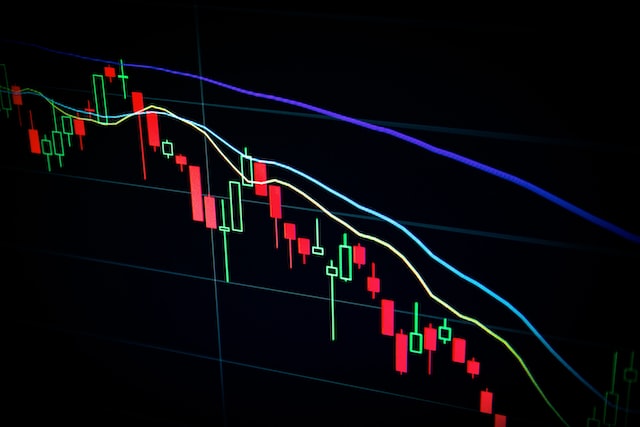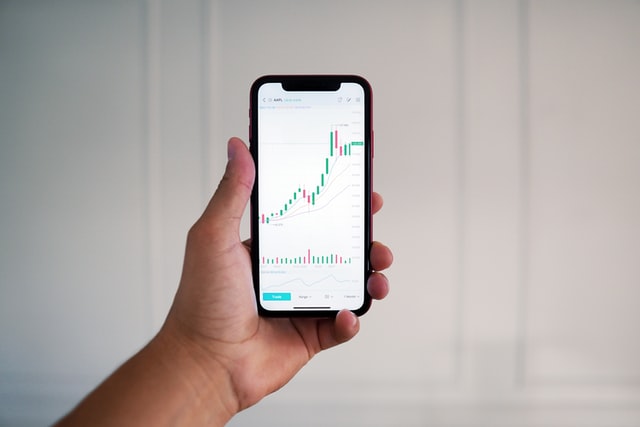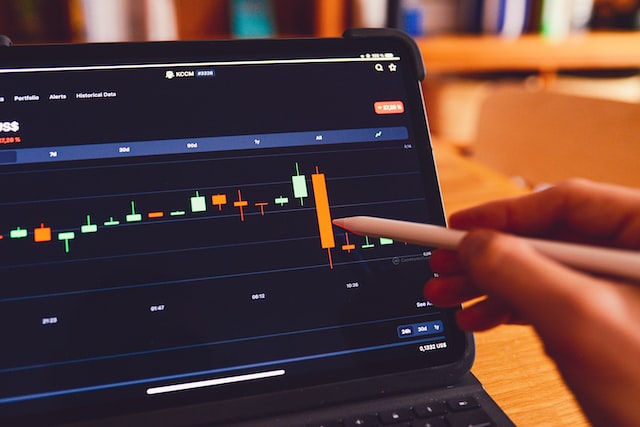Life is filled with repetitions, and those who recognize them will find themselves in a class of their own—particularly when it comes to pattern trading for equities. As the name implies, a pattern trading strategy is based on recognizing stock chart patterns and projecting their outcomes to profit from a position. It’s the most basic form of day trading.
Traders who focus on patterns and look for trading opportunities across various timeframes may be considered pattern traders. Trade chart patterns are a big idea that includes many different ways, some of which are similar in terms of significance. To be a master of trading the most profitable chart patterns, you must be attentive to patterns and recognize both which one is developing and what it implies in context.

A Pattern Trading Strategy’s Fundamentals
Some of these patterns may appear more difficult, but they all have the same goal. Traders who can identify and chart patterns can predict the market’s next move before it happens. Investors may establish a pattern trading strategy to make an informed guess in the stock market.
ABCD pattern: A simple four-point pattern that indicates a trend.
What Is the ABCD Pattern?
The ABCD pattern, as the name implies, is a four-step sequential action of a stock that may be seen in its reversal chart patterns. It has three price swings (A, B, C) and a buy/sell movement (D). This pattern can appear at any time and in any market. Here’s how it works:
A. The stock begins trading at high price movements and then drops.
B. The stock creates a new intraday swing low.
C. The stock moves through a new support level.
D. The stock has broken through the A-point.
The ups and downs of stock may appear chaotic to newcomers. However, establishing the highs, swing lows, and support levels gives traders a sense of how the stock will perform in the future. The ABCD pattern is a popular charting technique that analysts and traders use to predict market moves. There are three varieties of ABCD patterns, each with its own rules: AB=CD, Classic ABCD, and ABCD Extension. Each design has specific guidelines, but the idea behind them is a quantifiable change in price chart patterns. The time frame for stock to pass through the critical levels in an ABCD pattern varies.
Why Is the ABCD Pattern Important?
The ABCD pattern is the most obvious of all market patterns and is the foundation for others. Because it’s based on the Fibonacci sequence, a technique for dividing one number by another in a series, it’s easy to understand.
Traders seeking the critical Fibonacci ratio of 61.8% in the ABCD pattern are seeking. Point C should ideally be located at 61.8 percent of AB. If that’s the case, traders may utilize the sequence to forecast when to enter or exit their positions by charting the value of D using the Fibonacci sequence.
Identifying an ABCD pattern is the first step in recognizing other ways, such as a flag pattern or a rising/falling wedge. A convergence of patterns on top of the ABCD pattern is typically a strong indication that the stock is following predictable behavior. Traders will have more confidence entering or exiting a position at higher amounts because of this.
Common Mistakes in ABCD Pattern Trading
The most common mistake in ABCD pattern trading is looking for an ABCD pattern when there isn’t one. Indicators of an ABCD pattern can appear in active stocks that undergo significant price pattern change over a short period. Despite a clear path, determining support levels in these equities may be difficult.
When searching for ABCD patterns, keeping an eye on volume is critical as the pattern develops (thus action) and volume increases (as the trend reversal reaches its conclusion). A red flag is a low level of volume when the practice is emerging. The formation of the design may not be due to standard trading action. External circumstances may be causing the setup to become more violent than intended.

Flag pattern: A continuation pattern that indicates a price breakout.
Every day trader is waiting for a significant price drop to happen. And learning how to identify flag pattern trading may help you get on the break before it happens. Flag patterns are pretty common in stock charts. The red arrows indicate a stock’s surrounding price action potential to break apart or plummet quickly. They’re instrumental in unstable markets since they show investors’ faith in the firm’s long-term prospects.
What Is the Flag pattern?
When a stock is trending either up or down, it uses the trade pattern. The trade pattern shows when there’s continuous up and down movement in a stock that’s trading either way. Parallel lines may be drawn through the stock’s peaks and valleys, with breakpoints surpassing the previous peak or valley. The pattern’s name is aptly chosen, as it resembles a flag with the price break for the pole. Banners can be either bullish or bearish, depending on their orientation.
- A bearish flag occurs when the price declines but appears on the verge of a reversal.
- A bearish pennant is a reversal pattern in which the price moves up but is poised to fall after the breakout.
In essence, flag pattern trading signals a stock’s worth is doubtful. But, on the other hand, the break suggests that the market has made up its mind about the value, and there’ll be a big move either way to match it.
Why Is the Flag pattern Important?
Diamond pattern trading is a crucial trend because it provides stock price stability amid uncertainty. The recurring bouncing up and down indicates that a stock is having difficulties establishing support levels. If traders are unsure when to enter or exit a position due to uncertainty, this might create problems. However, when the break happens, it indicates that the trend will continue, and traders can feel safe in the continued rise or fall of the share price.
Several additional factors contribute to a flag pattern, which provides clarity and certainty to the stock’s action. The volume pattern is linked to a flag pattern, providing further insight into price changes.
Common Mistakes in Flag pattern Trading
Traders eager to get on a flag pattern may enter or exit their position too soon before the price breaks. As a flag pattern continues, it can give off false signals – peaks and valleys approaching previous highs and even exceeding them momentarily. You might want to wait for a price break to get the most out of your position. However, waiting until just before or during a price break may mean missing out on the significant move and profit potential that comes with it.
Many traders make the error of being excessively aggressive with their profit objective when using flag pattern trading. The best method to reach this goal is often to add the difference between the flag’s parallel lines and the entry point. Let’s assume that the entry point is $30, with a difference of $6 between the beginning price ($26) and the end price (32). The profit objective will be $36 if we aim too high. MISSING THE PRICE BREAK’S PEAK

Wedge pattern: A breaking pattern that indicates a price reversal.
Wedge patterns are another fundamental principle that most novice day traders must learn. It’s based on ABCD and flag designs. It’s also a more sophisticated indicator of market behavior, especially in the context of consolidation, and it takes cues from it. The primary aim of this pattern is to assist day traders in recognizing an opportunity for a price reversal and acting before it happens.
What Is the Wedge pattern?
Wedge pattern trading is similar to flag pattern trading in that it is based on the assumption of a price break imminent signified by price fluctuations trending upward. In contrast, the convergence of those oscillations into a concave area marks the end of the movement.
Wedges are similar to flags in that they’re marked by price swings, with peaks and valleys that a straight line can link. Wedges, however, move away from perpendicular rather than parallel to one another, as is the case with flags. Moreover, because the price falls near or at the point of convergence, it is pushed in the opposite direction from the trend lines. This is evident in both rising and declining wedges, for example.
- When a stock’s peaks rise, its valleys become steeper, creating rising wedges.
- Falling market wedges witness the slopes of a stock’s trend curve downward, but they are more vertical than the valleys.
Why Is the Wedge pattern Important?
Wedges help anticipate price breaks. Wedges, like flags, indicate instability and difficulties in maintaining a consistent support level, just as they do with price reversals. The confluence of the wedge, which is supported by a declining volume trend, suggests that price movement may be reversed. As the trend matures, buyers become more aggressive and sellers more conservative. This might assist in guiding a trader’s decision depending on their position.
Wedge patterns are successful because of their precision. According to studies, they’re more than two-thirds reliable predictors of a price change. Falling wedges are generally more predictive of a price break than rising wedges. Rising and falling trends wedges offer traders a foundation for accurately setting stop losses and anticipating price corrections.
Common Mistakes in Wedge pattern Trading
Like other pattern trading methods, Wedge pattern trading works best when looking at the fundamentals. Timing peaks and valleys might prevent the formation of a chart pattern. A break to the upside may indicate a further move in the direction of an upswing. As a stock approaches the interval, outside traders will be left waiting on the sidelines. For example, traders should take profits when a price breaks out of a declining wedge’s starting point.
Inaccurate wedge identification is another frequent blunder in wedge pattern trading. To be considered a simple wedge pattern, it must have at least three contacts on both sides of the wedge. It’s either a trending market or a pattern if there are fewer than three touches on both sides of the depression. Before a movement can break in the same direction, the market must test the support and resistance levels three times. This is also crucial for establishing suitable stop-losses. Setting appropriate levels is tough without a clear trend line.

Triangle pattern: A continuation pattern that signals a slowdown in volume.
What Is the Triangle pattern?
Day traders employ the triangle pattern trading technique to enter and exit their trades as prices stabilize confidently. Triangles are continuation patterns that do not feature price reversal patterns. In reality, the pattern’s momentum has only been reinforced rather than reversed. This is unlike a wedge formation in that the price continues to rise or fall after the point of contact.
Triangles are a form of support level in an overall trend. The decline in volume results in specific stability. Traders will enter or exit their trades, usually depending on the previous trend line.
Why Is the Triangle pattern Important?
Triangles are a significant illustration of trading psychology. Because they occur most frequently during a stock’s dramatic rise or fall, they’re an ideal place to take profits or capitalize on the trend continuations. Triangles are a crucial stabilizing element that lends credibility and integrity to a stock experiencing a rapid rise or fall. In the case of a stock’s meteoric ascent or decline, an ascending triangle can function as a more comprehensive level of support. When a stock breaches the triangle’s resistance line or support level, it indicates the confidence of buyers and short-sellers. This is why triangles are so crucial as a continuation pattern.
Common Mistakes in Triangle pattern Trading
Triangles are associated with volume. The direction in which the price is moving requires that the book be substantial. A triangle runs the danger of “rolling over” at the point of convergence if there isn’t enough volume behind it. A bearish engulfing shoulders pattern is one in which the price of an asset is enclosed by a higher price, going below and then surpassing the low point. This pattern forms look like a rising wedge, but it reverses instead of continuing.
It’s also crucial not to overextend oneself during a descending triangle pattern trading. The price patterns value between the first resistance level and the first support level is typically the maximum conservative projection of where the stock will move following a breakout. For example, suppose the difference between R1 and S1 is $8, and the share price breaks out at $60. In that case, it’s logical to aim for a goal of $68 on a bullish continuation pattern triangle or a double bottom of $52 on a bearish triangle.

Diamond pattern: A rare pattern for detecting reversals after a high or low.
What Is the Diamond pattern?
Not for novices! Not only are these patterns unusual, but they’re frequently wildcards that break down or up regardless of bullish or bearish chart patterns work. So it’s also critical for anyone who trades patterns to understand the fundamentals of a diamond pattern.
Diamonds are volatile and prone to shattering, which makes it difficult for traders to know when to enter or exit a trade. Don’t be fooled by the diamond’s apparent simplicity: They harm an expert trader. Conversely, profits may be substantial for those who play the diamond correctly.
Why Is the Diamond pattern Important?
As with many other forms of trading, diamond recognition trading is mainly concerned with investor psychology. This pattern analyzes a specific mentality that impacts the stock’s performance.
When a significant move occurs, investors are either eager to take profits (bullish) or to bet against the market (bearish). This initiates the first round of price reverses consolidation. After that, there’s a period of upheaval as investors become more confident in the volume. The second consolidation round is a pullback used to re-stabilize the price. Finally, the last breakout occurs when investors attempt to capitalize on the current level en masse. In essence, diamonds indicate uncertainty that investors can take advantage of.
Day traders who are seeking a more stable market may benefit significantly from being able to create certainty during tumultuous times. Likewise, investors who weather the consolidation in the back half of a triangle might benefit considerably from doing so.
Common Mistakes in Diamond pattern Trading
The worst blunder a trader can make is to trade diamonds early. Instead, treat the second half of the diamond-like formation as a symmetrical triangle, and draw trendlines support and resistance lines. Then, when the price breaks one of the thresholds, it signals which way the price will go next.
The most dangerous aspect of trading diamonds is setting target values and stopping losses. There’s no way to know how high or low a diamond’s break will go in a standard or technical indicators sense. As a result, many traders are either too safe or too risky in their benchmarking (due to factors beyond their control). The best chart patterns traders may only hope to look at the diamond’s debut or spike and use market momentum to anticipate the continuation or correction level after the break. Some traders compute the difference between a diamond’s high and low points and add it to the breakout.

Butterfly pattern: A reversal pattern that helps traders identify the end of a run.
What Is the Butterfly pattern?
Diamonds are called such because they appear on a stock chart. They begin with a significant increase or drop in price, followed by a leveling-out that is also accompanied by shrinkage. When the first contraction swings violently before contracting again, the diamond occurs just before another giant price swing. The difficulty is that traders can’t determine whether the subsequent price swing will be up or down until after.
The formation of diamonds is well-documented. The longer it takes for them to form, the more influential the following rally or decline will be. Diamonds that include over 10 to 12 trading periods are less volatile in the break than those that create over 25 to 30 periods.
Why Is the Butterfly pattern Important?
Butterfly patterns are significant since they indicate a reversal. Traders can calculate the reverse’s relativity based on these designs, which are harmonic, as long as they’re okay with Fib ratios. Moreover, these patterns tend to presage a trend’s end, which appeals to experienced traders.
The second reason why butterfly patterns are essential is that they’re pretty stable. Because the Fibonacci ratio generates stop-loss and price objectives, they’re simple to trade. If you have the technical know-how to define a butterfly properly, you may take action with moderate confidence in the Potential Reversal Zone.
Common Mistakes in Butterfly pattern Trading
It’s critical to carefully examine the Fib ratios in a butterfly pattern to ensure you’re not charting a bat or crab formation. The graphs are comparable harmonic structures, but they have varying ratios. Mistaking key ratios might influence how you chart the projected pattern and your levels.
Another indicator that the pattern is in its final form is when you can identify a trend. A butterfly chart pattern trading strategy won’t solidify until the design is finished. This implies you must figure out which legs to use to calculate Fibonacci ratios to see if they fit the way.

Why is Pattern Recognition Important?
Patterns are indicative of a particular activity. You may begin to forecast outcomes with reasonable accuracy if you know the phases in a sequence. A stock pattern is as quantifiable as any other design. For example, figure out the following numbers in this sequence: 2, 3, 5, 8, 13. If you said 21, it’s because you observed the pattern. This is a Fibonacci Sequence, the foundation for many stock trading chart patterns.
Traders with basic stock patterns and technical analysis expertise can anticipate market behaviour in various ways. It can also forecast when security will break up or fall. It may assist you in identifying stop-losses and support levels at a micro level. Finally, you may put it to use to generate money once you understand the pattern.
Common Mistakes in Pattern Trading
Obtaining too far ahead of the pattern may produce misinterpretation, much like with any form of pattern recognition. To begin, consider the components of a particular way; then, use fundamentals to extrapolate it. A pattern can be anticipated and then fail if the design takes longer to emerge or deviates. Therefore, using at least two points of resistance and two points of support as a guideline when developing a pattern-trading strategy is preferable.
The second most frequent blunder made by pattern traders is to look for shoulders patterns where none exist. Not every movement is a pattern signal. It’s easy to deceive oneself when it comes to making up stories—every trader wants to be the first on a new prevailing trend so they can take advantage of the early phases of momentum. Most traders lose money when a stock’s movement deviates from its pattern.
The Final Word on Pattern Trading Strategy
One of the most popular methods for investors to make informed stock selections is to recognize trends. A pattern trading strategy is the foundation of a daily trader’s approach. Those who can spot patterns and grasp the fundamentals behind them will benefit. However, designs aren’t always foolproof, especially if you’re ahead. Therefore, traders should brush up on the basics and create evidence-based patterns before attempting to trade against them.

Just Start Investing is a personal finance website that makes investing easy. Learn the simple strategies to start investing today, as well as ways to optimize your credit cards, banking, and budget. Just Start Investing has been featured on Business Insider, Forbes, and US News & World Report, among other major publications for its easy-to-follow writing.
